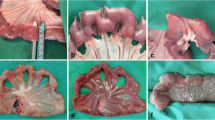Background: Small bowel transplantation represents a valid therapeutic option for patients with intestinal failure, obviating the need for long-term total parenteral nutrition. Recently, reports have shown the feasibility of performing living related intestinal transplantation using segmental small bowel grafts. The limitations of this technique include inadequate harvested small bowel lengths, as compared with the lengths obtained in cadaveric small bowel harvests, and large incisions for the donor. In this pilot study, we evaluated the feasibility of laparoscopically harvesting long segments of proximal jejunum for small bowel transplantation using a porcine model. The results can be used to evaluate the potential for applying this technique in human cases. Methods: For this study 10 yorkshire pigs were used. Under general anesthesia, each pig underwent laparoscopic segmental resection of 200 cm of proximal jejunum on a vascular pedicle. The harvested graft then was autoreimplanted using an open technique by anastomosing the vascular pedicle to the superior mesenteric vessels. Success was determined 2 hours after anastomosis by visually identifying a pink graft with viable-appearing mucosa, an artery with a strong thrill, and palpable venous flow. The animals were then sacrificed. Results: The mean operation time required to laparoscopically harvest the small bowel graft was 80 min (range, 35–120 min), and the mean length of harvested graft was 220 cm (range, 200–260 cm). The mean length of the graft's vascular pedicle was 4.5 cm (range, 4–5 cm). All 10 grafts were successfully harvested laparoscopically and then reimplanted using an open technique. All the grafts maintained good vascular flow, and showed no evidence of mucosal necrosis at necropsy. Obviously, further studies would be required to examine the long-term results of reimplanting a laparoscopically harvested small bowel graft, but proposals for such studies is beyond the scope of this report. Conclusion: Minimally invasive techniques can be used to harvest proximal small bowel grafts for living related small bowel transplantation.
Similar content being viewed by others
Author information
Authors and Affiliations
Rights and permissions
About this article
Cite this article
Kim, W., Gagner, M., Fukuyama, S. et al. Laparoscopic harvesting of small bowel graft for small bowel transplantation . Surg Endosc 16, 1786–1789 (2002). https://doi.org/10.1007/s00464-001-8249-9
Received:
Accepted:
Issue Date:
DOI: https://doi.org/10.1007/s00464-001-8249-9




